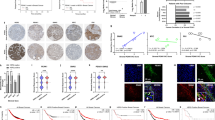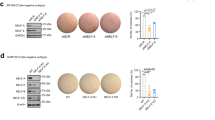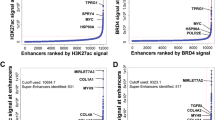Abstract
Krüppel-like factor 8 (KLF8) is a transcriptional factor critical for metastatic progression of breast cancer. Epithelial stromal interaction 1 (EPSTI1), a recently identified stromal fibroblast-induced gene in non-invasive breast cancer cells is highly overexpressed in invasive breast carcinomas. The function and regulation of EPSTI1, however, remain largely unknown. In this paper, we report a novel KLF8 to EPSTI1 signaling pathway in breast cancer. Using various expression analyses, we revealed a high co-overexpression of KLF8 and EPSTI1 in invasive human breast cancer cells and patient tumors. Ectopic overexpression of KLF8 in the non-invasive MCF-10A cells induced the EPSTI1 expression, whereas KLF8 knockdown from the invasive, MDA-MB-231 cells decreased the EPSTI1 expression. Promoter activation and binding analyses indicated that KLF8 promoted the EPSTI1 expression by directly acting on the EPSTI1 gene promoter. EPSTI1 knockdown dramatically reduced the KLF8-promoted MCF-10A cell invasion, and ectopic expression of EPSTI1 in the non-invasive MCF-7 cells is sufficient to induce the cell invasion. Experiments using nude mice demonstrated that the ectopic EPSTI1 granted the MCF-7 cells capability of both invasive growth in the breasts and metastasis to the lungs. Using co-immunoprecipitation coupled with mass spectrometry, we discovered that EPSTI1 interacts with the valosin-containing protein (VCP), resulting in the degradation of IκBα and subsequent activation of NF-κB in the nucleus. These findings suggest a novel KLF8 to EPSTI1 to VCP to NF-κB signaling mechanism potentially critical for breast cancer invasion and metastasis.
This is a preview of subscription content, access via your institution
Access options
Subscribe to this journal
Receive 50 print issues and online access
$259.00 per year
only $5.18 per issue
Buy this article
- Purchase on Springer Link
- Instant access to full article PDF
Prices may be subject to local taxes which are calculated during checkout








Similar content being viewed by others
References
Lahiri SK, Zhao J . Kruppel-like factor 8 emerges as an important regulator of cancer. Am J Transl Res 2012; 4: 357–363.
Lu H, Hu L, Li T, Lahiri S, Shen C, Wason MS et al. A novel role of Kruppel-like factor 8 in DNA repair in breast cancer cells. J Biol Chem 2012; 287: 43720–43729.
Lu H, Wang X, Urvalek AM, Li T, Xie H, Yu L et al. Transformation of human ovarian surface epithelial cells by Kruppel-like factor 8. Oncogene 2013; 33: 10–18.
Schnell O, Romagna A, Jaehnert I, Albrecht V, Eigenbrod S, Juerchott K et al. Kruppel-like factor 8 (KLF8) is expressed in gliomas of different WHO grades and is essential for tumor cell proliferation. PLoS One 2012; 7: e30429.
Urvalek AM, Lu H, Wang X, Li T, Yu L, Zhu J et al. Regulation of the oncoprotein KLF8 by a switch between acetylation and sumoylation. Am J Transl Res 2011; 3: 121–132.
Urvalek AM, Wang X, Lu H, Zhao J . KLF8 recruits the p300 and PCAF co-activators to its amino terminal activation domain to activate transcription. Cell Cycle 2010; 9: 601–611.
van Vliet J, Turner J, Crossley M . Human Kruppel-like factor 8: a CACCC-box binding protein that associates with CtBP and represses transcription. Nucleic Acids Res 2000; 28: 1955–1962.
Wang X, Lu H, Urvalek AM, Li T, Yu L, Lamar J et al. KLF8 promotes human breast cancer cell invasion and metastasis by transcriptional activation of MMP9. Oncogene 2011; 30: 1901–1911.
Wang X, Zheng M, Liu G, Xia W, McKeown-Longo PJ, Hung MC et al. Kruppel-like factor 8 induces epithelial to mesenchymal transition and epithelial cell invasion. Cancer Res 2007; 67: 7184–7193.
Wei H, Wang X, Gan B, Urvalek AM, Melkoumian ZK, Guan JL et al. Sumoylation delimits KLF8 transcriptional activity associated with the cell cycle regulation. J Biol Chem 2006; 281: 16664–16671.
Zhao J, Bian ZC, Yee K, Chen BP, Chien S, Guan JL . Identification of transcription factor KLF8 as a downstream target of focal adhesion kinase in its regulation of cyclin D1 and cell cycle progression. Mol Cell 2003; 11: 1503–1515.
Mehta TS, Lu H, Wang X, Urvalek AM, Nguyen KH, Monzur F et al. A unique sequence in the N-terminal regulatory region controls the nuclear localization of KLF8 by cooperating with the C-terminal zinc-fingers. Cell Res 2009; 19: 1098–1109.
Wang X, Urvalek AM, Liu J, Zhao J . Activation of KLF8 transcription by focal adhesion kinase in human ovarian epithelial and cancer cells. J Biol Chem 2008; 283: 13934–13942.
Wang X, Zhao J . KLF8 transcription factor participates in oncogenic transformation. Oncogene 2007; 26: 456–461.
Zhang H, Liu L, Wang Y, Zhao G, Xie R, Liu C et al. KLF8 involves in TGF-beta-induced EMT and promotes invasion and migration in gastric cancer cells. J Cancer Res Clin Oncol 2013; 139: 1033–1042.
Ding SZ, Yang YX, Li XL, Michelli-Rivera A, Han SY, Wang L et al. Epithelial-mesenchymal transition during oncogenic transformation induced by hexavalent chromium involves reactive oxygen species-dependent mechanism in lung epithelial cells. Toxicol Appl Pharmacol 2013; 269: 61–71.
Lu H, Wang X, Li T, Urvalek AM, Yu L, Li J et al. Identification of poly (ADP-ribose) polymerase-1 (PARP-1) as a novel Kruppel-like factor 8-interacting and -regulating protein. J Biol Chem 2011; 286: 20335–20344.
Gudjonsson T, Ronnov-Jessen L, Villadsen R, Bissell MJ, Petersen OW . To create the correct microenvironment: three-dimensional heterotypic collagen assays for human breast epithelial morphogenesis and neoplasia. Methods 2003; 30: 247–255.
Nielsen HL, Ronnov-Jessen L, Villadsen R, Petersen OW . Identification of EPSTI1, a novel gene induced by epithelial-stromal interaction in human breast cancer. Genomics 2002; 79: 703–710.
de Neergaard M, Kim J, Villadsen R, Fridriksdottir AJ, Rank F, Timmermans-Wielenga V et al. Epithelial-stromal interaction 1 (EPSTI1) substitutes for peritumoral fibroblasts in the tumor microenvironment. Am J Pathol 2010; 176: 1229–1240.
Zhang X, Yue P, Page BD, Li T, Zhao W, Namanja AT et al. Orally bioavailable small-molecule inhibitor of transcription factor Stat3 regresses human breast and lung cancer xenografts. Proc Natl Acad Sci USA 2012; 109: 9623–9628.
Meyer H, Bug M, Bremer S . Emerging functions of the VCP/p97 AAA-ATPase in the ubiquitin system. Nat Cell Biol 2012; 14: 117–123.
Buess M, Rajski M, Vogel-Durrer BM, Herrmann R, Rochlitz C . Tumor-endothelial interaction links the CD44(+)/CD24(−) phenotype with poor prognosis in early-stage breast cancer. Neoplasia 2009; 11: 987–1002.
Moserle L, Indraccolo S, Ghisi M, Frasson C, Fortunato E, Canevari S et al. The side population of ovarian cancer cells is a primary target of IFN-alpha antitumor effects. Cancer Res 2008; 68: 5658–5668.
Yang T, Cai S, Zhang J, Lu J, Lin C, Zhai J et al. Krüppel-like factor 8 is a new Wnt/beta-catenin signaling target gene and regulator in hepatocellular carcinoma. PLoS One 2012; 7: 6.
Asai T, Tomita Y, Nakatsuka S, Hoshida Y, Myoui A, Yoshikawa H et al. VCP (p97) regulates NFkappaB signaling pathway, which is important for metastasis of osteosarcoma cell line. Jpn J Cancer Res 2002; 93: 296–304.
Zubair A, Frieri M . Role of nuclear factor-kB in breast and colorectal cancer. Curr Allergy Asthma Rep 2013; 13: 44–49.
Ponomarev V, Doubrovin M, Serganova I, Vider J, Shavrin A, Beresten T et al. A novel triple-modality reporter gene for whole-body fluorescent, bioluminescent, and nuclear noninvasive imaging. Eur J Nuclear Med Mol Imaging 2004; 31: 740–751.
Carey BW, Markoulaki S, Hanna J, Saha K, Gao Q, Mitalipova M et al. Reprogramming of murine and human somatic cells using a single polycistronic vector. Proc Natl Acad Sci USA 2009; 106: 157–162.
Hockemeyer D, Soldner F, Cook EG, Gao Q, Mitalipova M, Jaenisch R . A drug-inducible system for direct reprogramming of human somatic cells to pluripotency. Cell Stem Cell 2008; 3: 346–353.
Tresse E, Salomons FA, Vesa J, Bott LC, Kimonis V, Yao TP et al. VCP/p97 is essential for maturation of ubiquitin-containing autophagosomes and this function is impaired by mutations that cause IBMPFD. Autophagy 2010; 6: 217–227.
Wiznerowicz M, Trono D . Conditional suppression of cellular genes: lentivirus vector-mediated drug-inducible RNA interference. J Virol 2003; 77: 8957–8961.
Zhao JH, Reiske H, Guan JL . Regulation of the cell cycle by focal adhesion kinase. J Cell Biol 1998; 143: 1997–2008.
Zhao J, Pestell R, Guan JL . Transcriptional activation of cyclin D1 promoter by FAK contributes to cell cycle progression. Mol Biol Cell 2001; 12: 4066–4077.
Zhao J, Zheng C, Guan J . Pyk2 and FAK differentially regulate progression of the cell cycle. J Cell Sci 2000; 113 (Pt 17): 3063–3072.
Acknowledgements
We appreciate Dr Vladimir Ponomarev of Memorial Sloan-Kettering Cancer Center for kindly providing the trimodal imaging reporter vector SFG-nTGL and Dr Qishan Lin of UAlbany for helping with the mass spectrometry. This work was supported by grants from NCI (CA132977) and Susan G. Komen for the Cure breast cancer foundation (KG090444 and KG080616) to JZ.
Author information
Authors and Affiliations
Corresponding author
Ethics declarations
Competing interests
The authors declare no conflict of interest.
Additional information
Supplementary Information accompanies this paper on the Oncogene website
Supplementary information
Rights and permissions
About this article
Cite this article
Li, T., Lu, H., Shen, C. et al. Identification of epithelial stromal interaction 1 as a novel effector downstream of Krüppel-like factor 8 in breast cancer invasion and metastasis. Oncogene 33, 4746–4755 (2014). https://doi.org/10.1038/onc.2013.415
Received:
Revised:
Accepted:
Published:
Issue Date:
DOI: https://doi.org/10.1038/onc.2013.415
Keywords
This article is cited by
-
Identification of EPSTI1 as a new potential biomarker for SLE based on GEO database
Clinical Rheumatology (2024)
-
Molecular classification and subtype-specific characterization of skin cutaneous melanoma by aggregating multiple genomic platform data
Journal of Cancer Research and Clinical Oncology (2018)
-
EPSTI1 polymorphisms are associated with systemic lupus erythematosus
Genes & Genomics (2017)
-
High expression of valosin-containing protein predicts poor prognosis in patients with breast carcinoma
Tumor Biology (2015)



